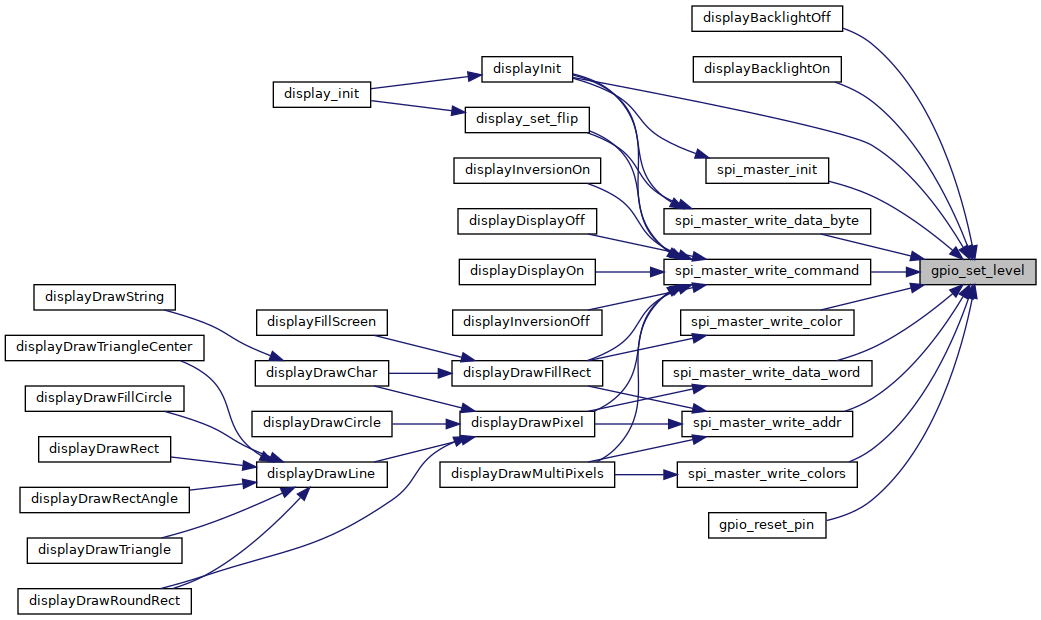GPIO library
Enumerations | |
| enum | gpio_direction_t { GPIO_DIR_INPUT = 0, GPIO_DIR_OUTPUT = 1 } |
| enum | gpio_level_t { GPIO_LEVEL_LOW = 0, GPIO_LEVEL_HIGH = 1 } |
Functions | |
| void | gpio_init (void) |
| void | gpio_destroy (void) |
| void | gpio_reset_pin (const io_t pin) |
| void | gpio_set_direction (const io_t pin, const gpio_direction_t direction) |
| gpio_direction_t | gpio_get_direction (const io_t pin) |
| void | gpio_set_level (const io_t pin, const gpio_level_t level) |
| gpio_level_t | gpio_get_level (const io_t pin) |
| void | gpio_reset (void) |
| bool | gpio_is_initialized (void) |
Detailed Description
Functions for General Purpose I/O (GPIO) access to leds, buttons, (analog) pins, etc.
All functions use the IO pin number (io_t) from 0..IO_NUM_PINS-1.
The LED and button libraries are built on top of this library, but do not expose the full functionality of this library. Use this library when that is required. Also see the I/O switchbox (switchbox.h) and pin mapping (pinmap.h).
In particular, be aware that the numbering used in the high-level libraries is different from the underlying GPIO numbering.
- The button library uses 0..3 or BUTTON0..BUTTON3, and 0..1 or SWITCH0..SWITCH1, whereas GPIO uses IO_BTN0..IO_BTN3 and IO_SW0..IO_SW1.
- The LED library uses 0..3 or LED0..LED1 for green LEDs whereas GPIO uses IO_LD0..IO_LD3. It uses 0..1 or COLOR_LED0..COLOR_LED1 and the three color components (RGB) whereas GPIO uses IO_LD4/5R/G/B.
- The PWM library uses 0..5 or PWM0..PWM5, whereas GPIO uses SWB_PWM0..SWB_PWM5.
- The UART library uses 0..1 or UART0..UART1, whereas GPIO uses SWB_UART0..SWB_UART1.
- The ADC library is slightly different. It uses ADC0..ADC5 (these are non-consecutive numbers), whereas GPIO uses IO_A0..IO_A5 (which are consecutive).
An example of using this library to turn LED0 on:
#include <libpynq.h>
int main (void)
{
gpio_init();
// set pin A0 to be an input pin and read from it
// alternatively, set A0 to be an output pin and write to it
sleep_msec(100);
// set LED 0 as output
// turn LED 0 on
sleep_msec(1000);
leds_destroy(); // turn LEDs off
pynq_destroy();
return EXIT_SUCCESS;
}
Enumeration Type Documentation
◆ gpio_direction_t
| enum gpio_direction_t |
◆ gpio_level_t
| enum gpio_level_t |
Function Documentation
◆ gpio_destroy()
| void gpio_destroy | ( | void | ) |
◆ gpio_get_direction()
| gpio_direction_t gpio_get_direction | ( | const io_t | pin | ) |
◆ gpio_get_level()
| gpio_level_t gpio_get_level | ( | const io_t | pin | ) |
◆ gpio_init()
| void gpio_init | ( | void | ) |
◆ gpio_is_initialized()
| bool gpio_is_initialized | ( | void | ) |
◆ gpio_reset()
| void gpio_reset | ( | void | ) |
◆ gpio_reset_pin()
| void gpio_reset_pin | ( | const io_t | pin | ) |
◆ gpio_set_direction()
| void gpio_set_direction | ( | const io_t | pin, |
| const gpio_direction_t | direction | ||
| ) |
◆ gpio_set_level()
| void gpio_set_level | ( | const io_t | pin, |
| const gpio_level_t | level | ||
| ) |
Set the level of the output IO pin. If the pin is configured as input, this function does nothing.
- Parameters
-
pin The IO pin to modify direction for. level The level to set on the pin.
- Warning
- Fails with program exit when pin is outside valid range.
Definition at line 7 of file gpio.c.
Here is the caller graph for this function:











